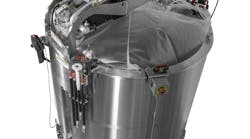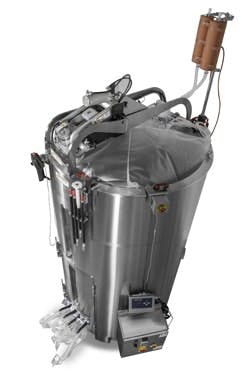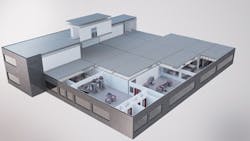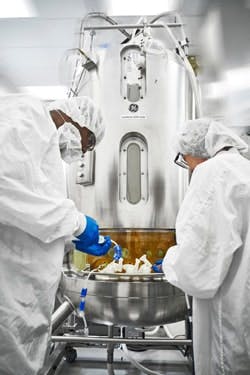The growth of single-use process technologies has exceeded many early expectations, as the experiences of Thermo Fisher Scientific and GE Healthcare Life Sciences show. This now is prompting more-traditional equipment manufacturers such as Emerson Automation Solutions to enter the market, too.
Several drivers account for the wide acceptance of single-use technologies today, according to Surendra Balekai, senior product manager, single-use technologies, Thermo Fisher Scientific, Logan, Utah. First, such devices reduce capital investment by 50–75%. Also, a fully validated plant can be up and running in 18 months — a year quicker than with conventional manufacturing technologies. Moreover, the single-use devices can provide greater than 90% savings from decreased demand for water for injection, energy, cleaning in place and sterilizing in place.
“In addition, the industry is changing. No company can survive by manufacturing a single molecule; multi-product facilities are what’s needed and this is ideal for single-use manufacturing technologies,” he notes.
So, for example, a manufacturer that currently uses a stainless-steel 12,000-L bioreactor is replacing it with six 2,000-L single-use bioreactors suitable for a mix of different products. “This is why so many biosimilar manufacturers opt for the single-use, multi-product solution. Assurance of supply is one of their key issues and having multiple capacities ensures this,” says Carsten Lau, global market development manager, single-use technologies, Logan, Utah.
Figure 1. Improved turndown ratio means that more can be done with fewer bioreactors. Source: Thermo Fisher Scientific.
An early adopter of this “six pack” strategy is CMC Biologics, a firm that provides contract process development and manufacturing of biopharmaceuticals with operations in Seattle, Wash.; Berkeley, Calif.; and Copenhagen, Denmark.
The company, which has worked with Thermo since 2009, installed a six pack of bioreactors into an existing space at its Seattle site. This not only allows CMC to manufacture any volume of product from 2,000–12,000 liters but also cut capital investment, while speeding up turnaround, validation and cleaning protocols.
Project teams at both companies now work closely together to meet the tight production timelines and ensure all supplies needed for bioreactor campaigns — which are planned 2–3 years ahead — always are in place.
[callToAction ]
Additional Incentives
Balekai points to two other important drivers over recent years. First, very significant advances in cell culture and growth media optimization have hugely increased expression rates. Just seven to eight years ago, expression rates were a couple of mg product/L but today they reach 6–8 g/L. “This has significantly reduced the capacity of the bioreactors required. So typically, one or a multiple of 200-L bioreactors is sufficient. Scale-out is a preferred option to scale-up,” he notes. In fact, since the company introduced its largest size bioreactor, a 2,000-L unit, in 2010, it hasn’t found customers clamoring for larger capacities.
Second, customers are looking to the future and the prospect of the whole process being single use: “With the advances in single-use mixers, heat exchangers, connectors etc., and their acceptance in compliance areas, this is possible.”
Lau points to advances in bioreactor turndown ratio. What was 2:1 not long ago is now 5:1, so fewer bioreactors are needed when scaling up from laboratory to commercial scale (Figure 1).
“Originally, you would move from the 2- to10-L flask then 50-, 250- and 1,000-L bioreactors. Now, you can scale up directly from the flask to the 50-L bioreactor and from there straight to the full 1,000 liter. Reducing the number of bioreactors reduces the initial plant cost but also reduces the consumables needed during the life of that plant. It also significantly decreases the footprint of a plant,” he explains.
The company continues to innovate. For example, its single-use mixer technology has moved from top mixing to bottom mixing. This gives a 100% mix-to-drain (i.e., mix until the last drop of liquid) option that is the only one of its kind on the market, says Balekai. Meanwhile, its single-use heat exchanger technology, which can heat or cool process fluids in non-jacketed tanks — both stainless steel and single use — is gaining increasing take-up.
The company also has introduced a twin-option integrity testing system. The first option involves manufacturer integrity testing, in which Thermo uses helium to check single-use bags before they ship. Second is point-of-use integrity testing at a customer’s production site. It is a qualification process that operates across single-use bag sizes from 1–5,000 liters.
Even so, regulation remains a concern for the industry. Suppliers originally qualified their single-use products on extractables and leachables (E&L) to Bio-Process Systems Alliance standards. Now, they must comply with the standardized extractables testing protocol introduced by the BioPhorum Operations Group. Guidelines from the United States Pharmacopeia are due out soon, too. “Testing to all these standards and to any others emerging in the next couple of years costs lots of money and time to suppliers. Not all can afford these costs. Standardization of E&L protocols will help suppliers,” explains Balekai.
Flexible Facility
GE Healthcare Life Sciences, which long has been active in single-use technology development, is promoting its FlexFactory biomanufacturing platform. This, in turn, underpins the KUBio concept (Figure 2): a flexible prefabricated cGMP biomanufacturing facility with a configurable production line that reportedly future-proofs capacity expansion, improves operational efficiency and minimizes infrastructure.
Figure 2. Modular approach to a prequalified, single-use facility promises many benefits. Source: GE Healthcare Life Sciences.
Customers were a bit doubtful at the outset about the ability to offer a complete, fully-qualified, off-the-shelf manufacturing plant, admits Johan Rosenquist, global operations director KUBio, Uppsala, Sweden.
“However, what we have found from our experiences so far is that interest is really growing from both small and large pharmaceutical manufacturers — especially when they are trying to establish themselves in new markets. We can have a facility up and running in under two years and often in 18 months. It’s pre-engineered and pre-designed to a customer’s specification and delivered at a fixed price,” he notes.
The company currently is working on its largest KUBio project to date, for manufacturing biopharmaceuticals at Pfizer’s $350-million China Biotechnology Center in Hangzhou, China. It involves delivery of 62 portable modules that are being manufactured in Germany.
All include single-use bioprocessing technologies together with heating, ventilation, air-handling systems, utilities and piping — 90% of what’s needed to run the facility. The center will use “numerous” 2,000-L single-use bioreactors when production begins in 2018, says GE.
Pfizer says it chose the KUBio route because it slashed factory construction time in half, to 18 months from three years, cut design costs by up to 50%, and will reduce carbon dioxide emissions by 75% and water and energy use by 80%.
Monoclonal antibodies and biosimilars are the main focus at the moment because they require the biosafety level 1 (BSL1) facilities currently offered by KUBio. GE plans to develop a KUBio plant that meets tougher BSL2 mandates and is talking to a couple of customers about this. The challenge here has been to standardize the process line so that it can be used to manufacture a number of different products — vaccines, for example.
“Any such plant would have to be very flexible — which is key to the KUBio concept — but at the same time requires more planning because of the stricter regulations that apply,” Rosenquist explains. “For example, a BSL2 facility requires unidirectional flow of people and materials; so they come in through one airlock and leave via a different one. With a BSL1 facility, bidirectional flow is normally used. One other requirement in a BSL2-solution is the air pressure zoning. You need to apply a solution that hinders air from the operational suites reaching the surrounding rooms and corridors. This is achieved by setting and monitoring different air pressures in each individual room.”
Echoing the experiences of Thermo Fisher Scientific, the company also has noticed a lack of demand for larger bioreactors.
“One plant I know of was using a 12,000-L stainless-steel bioreactor for its process. But the plant’s customer wanted to move to a smaller capacity, just-in-time-type manufacturing regime because if there was a problem with the original reactor the whole supply chain would have been wrecked,” explains Pontus Grebacken, enterprise solutions quotation manager for GE Heathcare Life Sciences in Uppsala. “Often space is an issue, too. Also, the focus on intensification and optimization technologies has increased upstream titers so that you can do more than ever before in small bioreactors,” he adds.
Even so, he cautions that single use is not a panacea — especially when running lots of similar batches or if downstream cleaning isn’t a big issue.
Hand-in-hand with rising interest in the technology is the demand for training. In June 2017, the company announced an agreement with the National Institute for Bioprocessing Research and Training (NIBRT), Dublin, Ireland, to open a new single-use center of excellence in Cork. The center will train over 1,500 engineers annually, to meet demand in Ireland and worldwide (Figure 3).
“NIBRT’s strategy is to continue to maintain high-quality facilities of direct relevance to the sector and with the continuing growth of single-use equipment, it was a logical next step to establish a single-use pilot plant for training and research purposes,” says Saara Nordenström, senior communications manager for GE in Uppsala.
Sensing An Opportunity
In 2018, Emerson Automation Solutions will make its first move into the single-use sensor technologies market. According to Marc Bumgarner, Shakopee, Minn.-based vice president and general manager of the firm’s pressure business and executive sponsor of its single-use sensor initiatives, a number of end-users approached the company to help particularly with accuracy and reliability issues associated with single-use pressure, pH and dissolved-oxygen sensors.
Figure 3. New Irish center will give engineers access to the latest single-use equipment and pilot-plant facilities. Source: GE Healthcare Life Sciences.
“We have expertise in miniaturization from our work in other sectors but this is a big challenge. We have had to get the size and weight of a sensor down to a level where it can be put on a bioreactor which might only be the size of a shopping bag,” he says.
For example, both the pH and dissolved-oxygen sensors are roughly 5 in. long, ¾ in. in diameter and weigh only a few ounces. The pressure sensor is 2 in. tall, ½ in. in diameter and weighs less than 2 ounces.
“We can’t use our traditional development approaches because this market is so different: different customers, different products, different technologies, different regulations, etc. So we are creating a separate organizational group solely focused on sensor solutions for life sciences,” notes Bumgarner.
The company now is prototyping a pressure sensor that will not require any radiation or sterilization treatment because it won’t contact the reaction media. Emerson also aims to put all the electronics into the pressure sensor, allowing direct connection to a distributed control system without the need for an intermediate device to amplify/convert the raw sensor output to a 4–20-mA signal. This will do away with the interference to which raw sensor signals are susceptible, he explains.
On the pH side, Emerson is particularly focusing on shelf life. Single-use pH sensors are kept in a buffer solution before introduction to the bioreactor. However, they are prone to going out of calibration as the buffer degrades. Typical shelf life is a year. Emerson has developed a sensor and a patented buffer solution that has a shelf life of three years. Trials currently are underway.
The company also is beginning to look at single-use conductivity sensors but has no launch date yet for them.
“Speed and flexibility will be key to the manufacturing process to ensure quick turnaround of new medicines/treatments. We are also seeing a move to continuous processing from batch processing. So our intent is to create sensors with multiple applications in the single-use market, i.e., that operate in batch or continuous processes, in upstream or downstream applications,” Bumgarner says.






